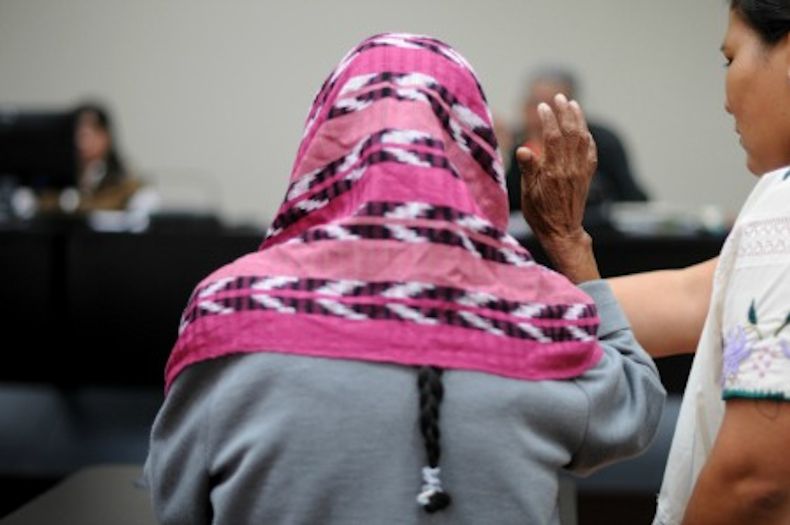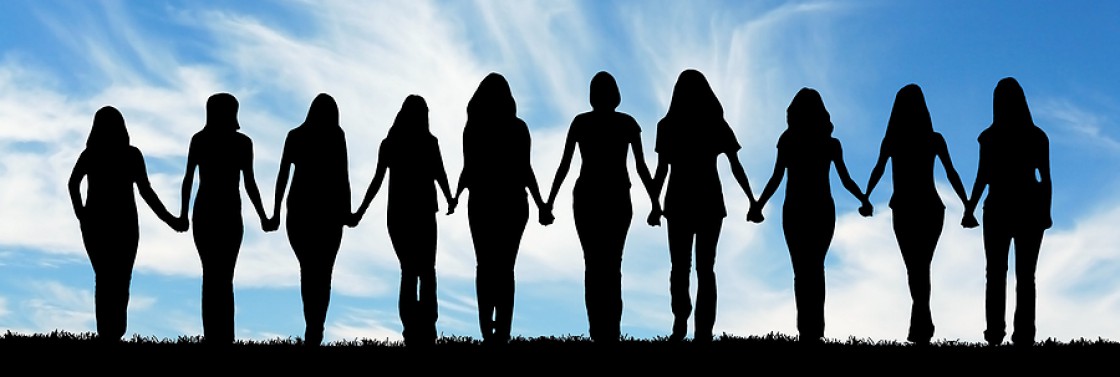
by Deep Green Resistance News Service | Feb 21, 2016 | Lobbying, Rape Culture
By Jhonathan F. Gómez / Upside Down World
All photos from Supreme Court trial by Jhonathan F. Gómez
Maya Q’eqchi’ women survivors recently entered the Supreme Court in Guatemala as part of the Sepur Zarco case to demand justice for sexual violence, sexual and domestic slavery, forced disappearances and murder, crimes committed during the internal armed conflict of 1960-1996. On February 1, 2016, Army Lieutenant Colonel Francisco Esteelmer Reyes Girón and military commissioner Heriberto Valdés Asij appeared before the court as another historic trial began.
The Sepur Zarco case is representative of the current state of justice for women in Guatemala. It serves as a reminder that the work towards bringing those responsible for genocide and crimes against humanity is an extensive and challenging process anywhere in the world.
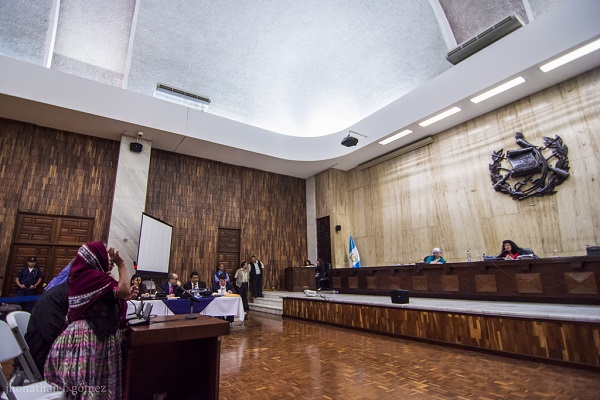
The case goes back to 1982, when the army built a military outpost between the departments of Alta Verapaz and Izabal. Built by forced labor from men of the communities of Panzós and El Estor, it was designated as a resting area for the troops. Late in 1982, the army captured and disappeared Maya Q’eqchi’ men who were fighting for their rights to the land in the area. Consequently, the army took advantage of the widowed women and declared them “alone and available,” forcing them into domestic and sexual slavery. The women were subjected to inhumane conditions, repeatedly raped, gang raped and forced to cook and clean for the army.
These crimes occurred when retired general José Efraín Ríos Mont Ríos Montt was president. Part of his government’s policy was to eliminate the Mayan people by way of displacement, disappearances, murder or forced exile. (Ríos Montt is currently waiting retrial to face justice for his crimes.)

In 1993, the United Nation’s Historical Clarification Commission collected testimonies which allowed for an understanding of what happened. However, a broader understanding of what took place began to surface further in 2000 when the Community Research and Psychosocial Action Team (Equipo de Estudios Comunitarios y Acción Psicosocial, ECAP) conducted psychosocial work with women of the Sepur Zarco region.
The roots of this landmark case are part of a living history which Maya Q’eqchi’ women have been working for years at the community level in the pursuit of justice. In 2009, an independent psychosocial investigation, which led to the publication of a book called Tejidos Que Lleva el Alma (The Weavings that Our Soul Carry) was conducted by ECAP and the National Union of Guatemalan Women (Unión Nacional de Mujeres Guatemaltecas, UNAMG). The book’s aim was to bring the stories of Mayan women survivors into the public consciousness.
In 2010, a symbolic Court of Conscience (Tribunal de Conciencia) against sexual violence for crimes committed during the armed conflict was conducted as a public act by the women survivors. It signaled a breaking of the silence and promoted the sharing of stories with the clear objective that nothing of that nature should ever happen again. The event was organized by various community organizations and with the support of multiple embassies including those from Costa Rica, Spain, Germany Norway and Sweden. Following the symbolic act, the women took a step forward with strategic litigation within the Guatemala justice system.
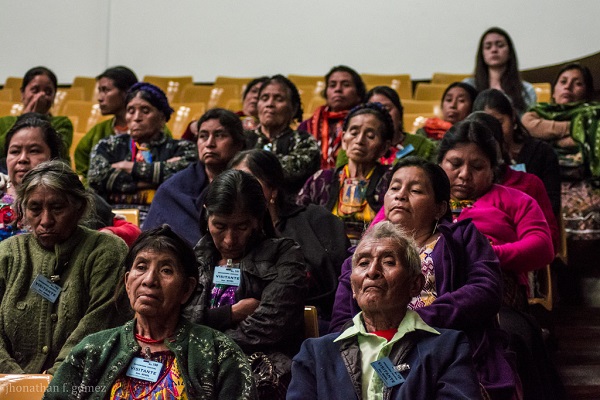
The Breaking the Silence and Impunity Alliance (Alianza Rompiendo el Silencio y la Impunidad), which consists of three grassroots organizations, came together the same year to accompany the legal proceedings of the women survivors. The women survivors have waited over 30 years to see any inclination of justice, and this case can therefore have a large impact in Guatemala and around the world.
The significance of the case cannot be overstated. It is the first time in the world where a national court, in the context of a criminal trial will hear charges against sexual violence during war, as well as the first time a national court will hear charges against sexual and domestic slavery, also in the context of war. The case can set precedents on how sexual violence is judged at a national and international level. Ada I. Valenzuela López from UNAMG states, “In our society, no one else will position sexual violence as an issue in this context. It is a violence which has been silenced for many years. It is almost never at the forefront of any debate in the courts or our society.”
The case stands to move public opinion forward in the struggle for gender justice. It can serve as a step to strengthen trust in a justice system that is capable of hearing the voices of women, and not shaming nor stigmatizing them for speaking out as survivors of sexual violence. It is particularly important for an indigenous population that has been historically discriminated and marginalized to trust in due process. Fifteen women have already testified during the intermediate phase of the case. Many of them have faced threats because of their testimony, yet all of them continue to stand strong because they share a collective understanding of the importance of the trial.
On September 2011, criminal charges were filed in Puerto Barrios, Izabal against military officials Reyes Girón and Valdés Asij. On December, 2011, exhumations were performed at the military outpost. In July of 2012, the prosecutor’s office requested before the Supreme Court that the case be transferred to the High Risk Court. In September of that year, survivors and witnesses presented testimonies before Judge Miguel Ángel Gálvez Aguilar who precedes High Risk Court B.
Arrests were made for Reyes Girón and Valdés Asij in June 14, 2014. On June 23, the first hearing was held and in October, the intermediate phase began which prompted the judge to request a trial date. Immediately after the defense filed a writ of amparo, a legal remedy for the protection of constitutional rights, which was rejected by the Constitutional Court in April of 2015.
In March, April and May of 2015, hearings were suspended because the defense attorneys were not present and because of health problems by Francisco Esteelmer Reyes Girón. Esteelmer Girón had been hospitalized and the defense stated that he was in “poor health.” On June 23, the judge restarted the public debate and the case was sent to the High Risk Court A, comprised by judges Yassmín Barrios, Patricia Bustamante and Gerbi Sical.
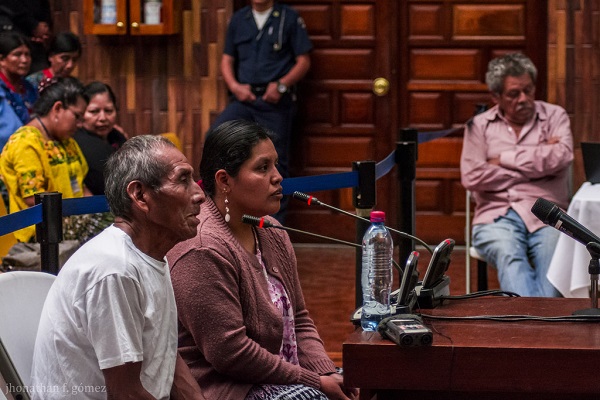
On February 1 of this year, the trial began. It faces many challenges, both in the domain of public opinion, as well as in the trial itself. The defense continues to defame survivors’ organizations, witnesses and uses legal methods to delay the trial. Many organizations have denounced the defense’s methods as a way to evade justice and promote a culture of impunity. Jo-Marie Burt from the Washington Office on Latin America reiterates that “the challenge here is to prove that these types of crimes can be investigated, brought to trial and judged. And to seek to generate mechanism or protocols for the army understand that violence against women cannot be used as an instrument of war, and that women are not war trophies.”
On February 9, the plaintiffs presented over 30 boxes as evidence which contained the remains found in various exhumations which the Forensic Anthropology Foundation of Guatemala (Fundacion de Antropologia Forense de Guatemala, FAFG) conducted. As the contents of the boxes were presented, many people who attended the trial as observers and supporters walked out of the courtroom because of their graphic nature. Evidence of this nature has not always been used at such trials, making it an even more important method of illustrating the magnitude of the crimes.
As a show of support for the Maya Q’eqchi’ women who will be testifying, women from various regions across the country have been present through the trial. As the country watches another historic trial unfold, the survivors are clear on their position. They seek justice and will not rest in peace until justice is served. They want to bring the issue of sexual violence into the public conversation and to show that it is hard for women to speak out against this type of violence. They want their voices to be heard, their truth to be known. They want society to understand that what happened to them was not their fault, and most importantly, that no other woman in Guatemala, or anywhere in the world, experiences what they lived through.
Jhonathan F. Gómez, is a documentary photographer currently living in Guatemala City. He is commitment to documenting the subaltern and diasporic realities of Guatemala as they relate to historic memory, race, class, gender, sexuality, identity and justice.
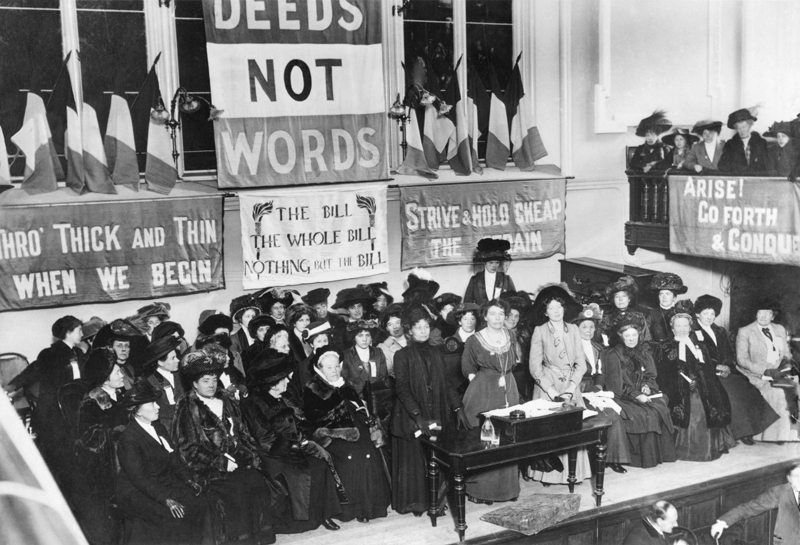
by Deep Green Resistance News Service | Feb 13, 2016 | Male Violence, Movement Building & Support, Strategy & Analysis, Women & Radical Feminism
This is the second part of a series. Read the first part at Toward Strategic Feminist Action.
By Tara Prema / Gender is War
Developing an effective response to the worldwide crisis of male violence
Strategic Feminism is a framework for collective action against patriarchal violence. The framework is based on acknowledging that the struggle for women’s liberation can – and must – adapt the lessons of asymmetric conflicts, such as guerrilla uprisings against occupying armies. We can apply the lessons of successful insurgencies to our aboveground organizing. And we must do so. It is a matter of life and death: every minute, men rape, abuse, abduct, and murder girls and women. Time is short – we must prepare for worse still to come.
Strategic Feminism draws on the excellent analysis of asymmetric conflict in Deep Green Resistance: A Strategy to Save the Planet. In Part One, we discussed the crisis of male violence against women and sketched a solution based on organizing for action in our communities. Here in Part Two, we look at more ways to begin and sustain our work for radical social change.
We call this model Strategic Feminism because it’s outcome-oriented and focused on creating a movement that addresses the material conditions affecting women’s lives.
Sustaining a movement: Feminism in collapse
How can we create a movement in a time of collapse? How do we come together as a force for change when individuals burn out, groups fall apart, and coalitions fracture? When feminists are fighting each other on questions of gender, motherhood, sexuality, and privilege?
And how to do we take these steps now, when every day brings more signs of cultural, economic, and environmental collapse? How do we adapt our strategies to a world order that is reeling from one crisis to the next? This is our challenge.
As radical women, we must pledge to protect each other and the places we love, just as women have done since the time they burned us as witches.
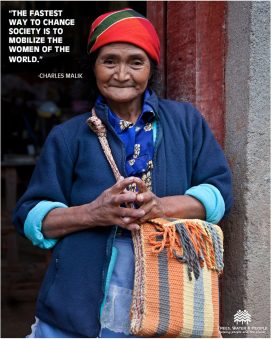 Keeping the spirit
Keeping the spirit
At the core of this movement, there is an intangible force with a measurable impact. It’s an attitude, a mindset, a determination that compels us to push back against oppression. It’s the warrior mindset, the stand-and-fight stance of someone defending her home and the ones she loves.
Many burn with righteous anger. This is important – anger lets us know when people are hurting us and the ones we love. It’s part of the process of healing from trauma. Anger can rouse us from depression and move us past denial and bargaining. It is a step toward acceptance and taking action.
Rewriting the trauma script includes asserting our truth and lived experiences, and naming abuses instead of glossing over them. It includes discovering (and rediscovering) that we can rely on each other instead of on men. It’s mustering the courage to confront male violence. But it’s not going to be easy.
Acknowledge and #NameTheProblem
We can’t fight a problem we can’t identify, especially when it is deliberately obscured. It’s not surprising that naming the problem has become a political act. And the problem is male violence against women. We shouldn’t have to say “she was raped” when we know that “men raped her.”
Reclaim what was taken from us
- Learning (and re-learning and reminding each other) that our bodies and spirits belong to us, we deserve to be safe, and we have the capacity to defend ourselves
- Fighting isolation and connecting with other women who have a similar fighting spirit
- Creating a culture of resistance to male violence
Taking action
Strategies are the paths to the goal. Tactics are the means to implement strategies. Part of a strategy for sustaining a movement is networks of peer support, mutual aid, and solidarity. We start by coming together with our peers, women who share the same goals and principles.
Goal: Develop a thriving network capable of effective action
Strategy: Find women allies and start a group
Tactics:
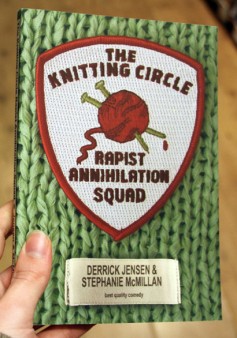 Start with a small circle: each one invite one.
Start with a small circle: each one invite one.- When you get an invitation, go!
- Use a petition or sign-on letter to gather potential recruits.
- Screen and interview volunteers.
- Discuss and write up a basis of unity
- Hold meetings, discussions, films, work parties, and benefit shows.
- Keep a signup sheet and a list of participants.
- Retain volunteers through appreciation and peer support.
- Raise money for projects and community campaigns.
Strategy: Start with an existing group
- Entryism – add members until your crew has a majority
- Headhunting – join in order to recruit members to your group
- Affinity group – organize an action team within the group
- Symbiosis – utilize the group’s resources and membership for your project
Strategy: Build a coalition
- Circulate a sign-on letter
- Organize against a common political enemy
- Host an event: A symposium, press conference, rally, or direct action
- Pledge to support and not publicly denounce each other
- Collaborate together on an ongoing project
Strategy: Keep each other safe and supported
- Have designated safe houses and emergency plans
- Set up a legal defence fund and legal team before they’re needed
- Create a mutual aid network so women activists can support each other
- Make and distribute an activist safety/security plan to stop online hackers and physical attackers
- Prioritize peer support and peer counseling, whether it’s formal or informal.
- Keep a “not wanted” list to weed out known disruptors
- Host group self-defense and security awareness trainings
Choosing our battles
How do we decide on a particular project, campaign, action or strategy? We can ask:
- Is it effective? What will it achieve?
- What are our goals (immediate and long-term )? How does this action lead there?
- Who is working with us?
- Do we have community support? From which communities?
- What decision-makers are we targeting?
- What are our strategies and tactics? (Legal, confrontational, revolutionary?)
- Do we have the resources? (People power, funds, vehicle?)
- How can we get the resources? (Recruiting, crowdfunding, direct appeals?)
- What are the possible negative outcomes? How can we mitigate the negatives?
Some actions and projects aren’t intended to lead to concrete results – they are symbolic in nature but still useful for boosting morale, getting media attention, and recruiting volunteers.
Male allies
Male allies can – and should – make substantial contributions to the movement. Consider asking women what we need to sustain our work, and then providing that without judgment or trying to exercise veto power. Men who take on ally roles should turn to other men for peer support and take time to debrief with them regularly.
Remember to regroup
Every campaign, project, and group will stall eventually. We invariably reach the point when it seems our efforts are going nowhere and our adversaries are dragging us down. This is when we must re-group and re-commit ourselves or fail. Every goal worth fighting for is going to face a serious backlash from those in power.
In spite of all our planning, our groups and coalitions still fall apart due to lack of unity, loss of commitment, burnout, and the divisive pressures of racism, classism, misogyny, and disruption from outsiders. Overall, things are not going to get better on their own. In the endgame of capitalism, the situation for women as a class worldwide is deteriorating at a fearsome rate. It’s up to us to prepare for the worst.
In the short term, this anti-feminist backlash is intensifying. Planning now is crucial. Some readers may not see the immediate need for this laundry list of tactics and strategies. But the day is coming when the need for community networks of trust will be urgent, because so much of what we rely on now has collapsed.
These notes come from unceded indigenous territory on the frontier of resistance to the western patriarchal invasion.

by DGR Colorado Plateau | Dec 18, 2015 | Colonialism & Conquest, Male Supremacy
by Courtney Parker / Intercontinental Cry
“The coercive sterilization of Indigenous women in Canada is genocide proper,” Dr. Karen Stote, professor at Wilfrid Laurier University and author of An Act of Genocide: Colonialism and Sterilization of Aboriginal Women, asserted in a statement to Intercontinental Cry (IC) . Her distinction alludes to the alternative phrasing of ‘cultural genocide’, a semantic preferred by judges, policy makers and other Canadian officials when referencing the plight of Canada’s First Nations.
Stote elaborated that, “…imposing measures to prevent births within a group, when done to undermine the ability of a group to continue to exist, is an act of genocide”. The crime is fully realized “…when [this] coercive sterilization is understood within the larger context of colonialism, as one of many policies/practices imposed on Indigenous peoples that allows the increasing encroachment of Indigenous lands and the reduction of the number of those to whom the federal government has obligations.”
Dr. Kim Anderson, Cree/Métis writer and fellow Wilfrid Laurier professor who specializes in community engaged research in Indigenous communities, supported Dr. Stote’s statement in a phone conversation with IC. “Genocide is the term for [these] systematic strategies. The ultimate end of sterilization is that people are unable to have children and that’s genocide.”
Anderson spoke of the many stories emerging from inside her own personal network of First Nations women today, stories detailing events that took place in Canada as recently as the 1960’s and 1970’s. She went on to contextualize them in reference to a larger, more compounded strategy of genocide on Canada’s First Nations’ families. Rather systematic in approach, attacks against Indigenous family structure and even more specifically, “Indigenous mothering,” have been methodically inflicted going back to first contact. Anderson painted a picture of deep sociocultural wounds from strategic attacks that pierced the most sacred parts of Indigenous life; she described how this frightening history of oppression and abuse made the sterilization era all the more traumatic, in the context of Canada’s greater colonial grand strategy.
A universal legal definition of genocide was outlined in Articles II and III of the Convention on the Prevention and Punishment of Genocide in 1948. According to Article II, the two main elements of genocide are the “mental” and the “physical.” The mental element considers the “intent to destroy, in whole or in part, a national, ethnical, racial or religious group, as such.”
The physical element is itemized into five parts: killing members of the aforementioned group, causing serious bodily or mental harm to group members of the aforementioned group; causing serious bodily or mental harm to group members; “deliberately inflicting on the group conditions of life calculated to bring about its physical destruction in whole or in part;” “imposing measures intended to prevent births within the group;” and, “forcibly transferring children of the group to another group.”
These criteria are what Stote refers to when she describes Canada’s handling of its First Nations residents as “genocide proper.” Perhaps a more palatable term to some, cultural genocide has made its way into the larger conversation; its presence there nuanced in a manner that is alternately valuable and distracting.
The terminology of “cultural genocide” is currently used by Canada’s Truth and Reconciliation Commission as a description of Canada’s policies of forced removal and residential schools. In relation to this – and to how much work really does still need to be done to address Canada’s colonial legacy – Anderson was quick to point out a disturbing statistic: there are more First Nations children in the Canadian welfare system now, than were removed to residential schools in the previous era.
Though care must be taken to prevent a battle of semantics from overshadowing these very real and very current issues, there are times when these nuances do matter; even more if they play host to evasion strategies of the hegemonic variety. One of the themes Stote explores in her book is Canada’s role and responsibility – in collusion with other hegemonic, western interests operating at the “UN level” – for the deletion of the article on ‘cultural genocide’ from the 1948 Genocide Convention.
To be clear, Canada actually went as far as threatening to opt out of the entire Genocide Convention if it was included, and was a direct force in the collective opposition that culminated in its removal. Interestingly enough, the measure was supported by the entire Soviet Bloc, while its critics – other than Canada – included the U.S. and most of Western Europe. There were two notable environmental factors contextualizing this sequence of events.
First of all, these circumstances were unfolding in the wake of Hitler’s genocide in Germany; and protections geared specifically at “culture” were presented as superficial in comparison. Secondly, it was all taking place on the cusp of the McCarthy era. It is conceivable that western interests were preemptively protecting other systematic strategies that were being developed – and executed – to target communist, or otherwise political groups, from appearing on the radar of Convention upholders. In any event, the terminology was omitted and with it, the legitimacy of ‘cultural genocide’ under international law. The terminology was revived in 2007 as part of the United Nations Declaration on the Rights of Indigenous Peoples, but was again ultimately excluded in favor of the more succinct expression of “genocide.”
The practices of coerced and forced sterilizations of Indigenous women – and men – must also be understood in the context of both what appears to be this large scale appeal for genocidal impunity, and as well within the violations of basic consent. The American Bar Association outlines a complex set of standards regarding a ward of the system’s ability to give consent in terms of biomedical practices and research. Indigenous peoples in some contexts – trapped in the cyclical patterns of settler violence and imperialistic intrusion upon their lives and culture – especially historically, were definitively unable to give legal consent, even when consent was sought – be it under the most pretentious of terms considering Indigenous peoples were veritable prisoners of war at this point in Canada’s history. Accordingly, an examination of historical documents by Stote revealed “problems: such as a lack of interpreters, … a lack of informed consent, [or] consent forms not being translated into the languages spoken by Indigenous peoples.”
The extent to which Canada was coloring outside the ethical lines with their practices of forced sterilization is further realized in terms of another case in point. Stote related that,
The first high dose birth control pill was being prescribed in Indigenous communities, 1964-1965 at least, before contraceptives were legalized for these purposes – in 1969 – with the intent to reduce the birth rate, and to “reduce the size of the homes the federal government would need to provide.
Considering the Catholic Church’s position on birth control, it might be assumed that their own activity in relation to Canada’s First Nations during this period would steer far and wide from the government’s unholy interventionism. It is therefore especially confusing that they actually worked in collusion with the Canadian government in terms of these methodical strategies to wipe Canada’s First Nations off the face of the planet. This unholy alliance is perhaps most evident in Canada’s long-running policy of forcibly removing Indigenous children from their homes and families, and imprisoning them in residential Christian schools funded by the state. As detailed above, this practice stands on its own as a violation of the Geneva Convention, even after the phrasing “cultural genocide” had been struck from the official document.
After a six year investigation, The Truth and Reconciliation Commission concluded that:
The Canadian government pursued this policy of cultural genocide because it wished to divest itself of its legal and financial obligations to Aboriginal people and gain control over their lands and resources. If every Aboriginal person had been ‘absorbed into the body politic’, there would be no reserves, no treaties and no Aboriginal rights.
During a recent trip to Bolivia, Pope Francis issued an apology for the “sins” the Catholic Church committed against the Indigenous of Latin America. Members of Canada’s First Nations would undoubtedly be well served by a similar statement from the (if ambivalently) human rights-oriented Pope. Canadian First Nations organizers were disappointed that former Canadian Prime Minister, Stephen Harper, did not issue a more direct appeal for an apology for the Church’s role in the residential schools when he met with the Pope recently. Assembly of First Nations Chief Perry Bellegarde strongly lamented that move (or lack of one) citing at the time:
Today would have been a powerful and appropriate day to issue that invitation and it would help survivors in their healing journey.
Enter in Justin Trudeau, Canada’s newly elected Prime Minister and Leader of the Liberal Party, who quickly responded to the Truth and Reconciliation Commission’s release of its final report detailing Canada’s history of residential schools on December 15, 2015. The report documents a horrific legacy of physical and sexual abuse that culminated in an official death toll of 3,200 — though Commission chairman, Justice Murray Sinclair, estimates the actual number to be much higher.Trudeau’s comments — themselves a potential harbinger of a long awaited policy pivot — came after he met with leaders from 5 First Nations communities in Ottawa on December 16th.
To bring the discussion back to coerced and forced sterilization, it is important to note that these atrocities were certainly not limited to Canada. These ethical anomalies are well documented to have occurred in many other nation states as well, including the United States of America.
In 2000, the American Indian Quarterly journal published an article entitled, “The Indian Health Service and the Sterilization of Native American Women.” Researchers concluded their assessment with encouraging news regarding more recent trends concerning Native autonomy in health care practices, but laced any implied optimism with a warning:
While the sterilizations that occurred in the 1960’s and 1970’s harmed Native Americans, Indian participation in their own health care since 1976 has strengthened their tribal communities. Sterilization abuse has not been reported recently on the scale that occurred during the 1970’s, but the possibility still exists for it to occur.
To punctuate that ultimately prophetic statement is a much more recent case from Peru, in which around 350,000 women – the majority of whom were Indigenous Quechua, Aymara, Shipiba, or Ashaninkas – were coercively sterilized by a government health program under the administration of former President Alberto Fujimori. (Fujimori was later sentenced to 25 years in prison for grave human rights violations not directly related to sterilizations.)
The issue of consent loomed large in Peru as well. Sometimes the procedures were done completely in secret after childbirth, and sometimes the only form of consent was a waiver signed by a relative (disturbing, from a few angles, given the language barriers.) There were a number of factors that disabled proper consent protocol, and likewise a number of negative impacts women experienced in the aftermath.
Alejandra Ballón, who has written a book about the procedures in Peru under Fujimoto, noted that, “The women lost their strength and could no longer work as farmers, but also many were abandoned by their male partners, and forced to immigrate to the cities.” In November of 2015, a mobilization of about 80 Peruvian women – victims of these practices of forced sterilizations between 1996 and 2000 – took to the streets demanding justice.
It’s impossible to know if there are similar accounts of impact on the victims of forced sterilizations in Canada, because the necessary research has not been carried out. According to Anderson, this is what makes Stote’s ongoing work so important. She also points to the need to collect the stories of Canada’s First Nation eugenics-era survivors, while they are still alive. She may even take on the latter task herself, having had a dream about it.
Anderson further contextualized Canada’s history of sterilizing its First Nations women as being spawned from this broader eugenics movement that was born out of the writings of Francis Galton, cousin of Charles Darwin, who coined the term “eugenics” in 1883 . It was a movement, she points out, that Indigenous peoples were constantly targeted by.
Seven years before Nazi Germany passed the Nuremburg Race Laws that outlawed German Jews from having sexual or marital relations with anyone of German or mixed ancestry, Alberta passed “The Sexual Sterilization Act” in 1928. The legislation outlined the conditions and procedures for sterilizing individuals who were deemed to have “undesirable traits.” Five years later, in 1933, British Columbia passed a law of its own, “An Act Respecting Sexual Sterilization.” Like its eastern counterpart, British Columbia’s legislation outlined the who, the where, and the how in regards to sterilization of those who were considered wards of the state and possessed some sort of “undesirable trait.”
One has to wonder, as professor and Lakota-American, Dr. Lehman Brightman did during his historic speech at the end of “The Long Walk” in 1978 (which followed the famous occupation of Alcatraz in the late 1960’s and early 1970’s) if this “trait” was in fact resource-rich land and unconquered territory. Brightman proclaimed, regarding Natives in the United States at that time:
We won’t have any need for reservations if we don’t stop the sterilization of our youth, and of our women, and of our men.
Even amidst the height of these draconian practices, most of the time the need for actual consent was at least legally recognized. In other words, it is possible that B.C. was breaking its own laws in regards to methods used to forcibly sterilize Canadian First Nations women.
Arizona State professor, Dr. Myla Vicenti Carpio, published an article in 2004 called, “The Lost Generation: American Indian Women and Sterilization Abuse,” in which she charges that:
The United States filters monies through agencies such as the U.S. Agency for International Development [USAID], the Rockefeller Foundation, and the Ford Foundation for population control programs. These agencies were responsible for the sterilization of men and women in regions such as Puerto Rico, Brazil, Guatemala, Africa, and Panama.
Exact figures are unattainable in terms of just how many Native Americans were sterilized in the U.S. during the 1970’s. Brightman, who devoted much of his life’s work to the issue, put his educated guess at about 40% of all Native American women alive at that time, and 10% of Native men. Brightman figured that the total number of Native women sterilized during that decade was between 60,000 and 70,000, and has labeled it “criminal negligence and criminal genocide.” Citing the language issues, among other issues related to consent, Brightman asserted: “They’ve sterilized all of our women by trickery, by fraud and by crook. They’ve asked them to sign consent forms that they couldn’t read, in English; they’ve sterilized them without telling them about it; and they’ve sterilized them by lying to them and telling them the operation was reversible.”
Documented survivor counts are accumulating among Canada’s First Nations community as well. According to Stote: “We know (according to other researchers, i.e., Christian, 1974 and Grekul, 2004) Indigenous peoples were targeted under Alberta’s eugenic legislation (1928-1972), making up 6-8% of those sterilized overall, despite only being about 3% of the population; although in later years (1969-1972), they made up over 25% of those sterilized.”
Stote’s own research – reviewing the first of three federal files she searched in all – uncovered sterilizations performed on Indigenous women at 14 different federally operated Indian Hospitals across Canada. Another set documented sterilizations on First Nations women from 32 different northern settlements; and, a third set detailed the experiences of women from the Baffin, Keewatin, Mackenzie, and Inuvik zones.
Unfortunately for Canada’s First Nations, neither sterilizations nor history are easily reversed; and as such, neither are the sustained impacts of the genocide of eugenics. One of the surest ways to make sure these tragedies of recent history are not repeated in the present or future, is to heed the call to aggregate and document the collective and individual stories and memories of Canada’s First Nations women who are still living with the effects.
In terms of relevance in modernity for Canada’s First Nations, Stote explained to IC that:
I think the discourse of blaming individuals for social problems, for the poverty conditions in which they live, and for having children they “can’t afford” is still very much with us. It is more cost effective to blame individuals, and to view them (or their reproduction) as the cause of their situation rather than examine the larger political, economic and social system in place that creates poverty, social problems, etc. And for Indigenous women in Canada, but many other places as well, it is conditions of colonialism and the failure of the federal government (settler population in general) to uphold obligations to Indigenous peoples that is creating the marginalized status and poverty conditions in which Indigenous peoples are forced to live. These conditions of colonialism are ongoing.
These very issues have come to a head recently as yet another First Nations woman has come forward with an account of a recent sterilization that occurred outside of the boundaries of proper consent. Melika Popp, a Saskatoon woman who was sterilized after the delivery of her first child, was assured the process was reversible and shared, “I felt very targeted. It was under duress. I was definitely hormonal at that time.”
For more recent survivors like Popp, the struggle to come to terms with ongoing impacts has just begun. Others have been carrying these burdens for decades without a platform on which to speak out. In terms of what it will take to jumpstart the healing process for all, thus allowing Canada’s victims, their families, and their communities to move forward, Anderson had some words:
Story-telling and testimonial can be a healing process for people, to [realize] that their voice and their story is heard. In general, North Americans are really uninformed about Indigenous history on the continent and the brutality that was involved, and maybe are resistant to learning about that because it triggers all sorts of other feelings, like white guilt, but the only way to go forward is to work with the truth. It is also important to talk about it within the framework of assessing the family breakdown. Family is so important to Indigenous cultures…the attack therefore has been so devastating…recognizing and naming this is a significant form of healing.
According to recent reports, a surprising leader in the race to make amends on issues of forced and coerced sterilizations is the southeastern state of North Carolina. North Carolina announced their intentions to be the first state to financially compensate victims of its particularly aggressive sterilization programs, in early 2012. Estimates cite that North Carolina alone sterilized 7,600 people between 1929 and 1974. Out of 768 claims made, 220 living victims were designated to receive checks of $20,000 each. Under the compensation policy, the sterilizations had to have taken place under the state’s Eugenics Board; unfortunately, various judges and social service workers were apparently “greenlighting” them off the books as well.
Stote also weighed in with some insight about how Canadians can move forward as a whole on the trajectory towards justice and healing.
On an individual basis, I think those on whom these injustices were perpetrated should be asked about what needs to be done. Gathering the details of what happened, when, on whom, and under what conditions, would be made much easier if there was an honest and forthcoming attempt to, at the very least, acknowledge [that] this type of thing happened to Indigenous peoples in Canada. More broadly, I have consistently heard and seen Indigenous peoples struggling for the right to self-determination as peoples, to have their ways of life respected, their bodies respected, and to have settlers uphold their end of the original responsibilities and relationships that were laid out between them and Indigenous peoples. So, I see that as a great place to start. I think this will require Canadians to really take the initiative in learning our history, and to challenge those we have been allowing to make decisions on our behalf. This will ultimately need to include a restructuring of our social, political and economic life in Canada.
Keri Cheechoo, a Cree woman from the community of Long Lake #58 First Nation, and a PhD. Candidate at the Faculty of Education at the University of Ottawa, offered some final thoughts in a statement to IC:
As peculiar as it sounds, I awoke at about three in the morning with two words swirling in my mind: forced sterilizations. I scribbled them down on the back of a receipt and went back to sleep. The next day I began reading and engaging in dialogue with those both close to me, and in the Academy, and I began to realize that the scope of forced or coerced sterilizations in Indigenous women is both appallingly enormous and disturbingly concealed.
It is my opinion that forced or coerced sterilization is an act of violence on Indigenous women. The colonial agenda of genocide that was endorsed in the form of forced or coerced sterilization of Indigenous women contributed directly to the colonization of the land. Indigenous women are conduits, we are connected to the land in an esoteric way, and a permanent loss of reproduction and reproduction rights directly impacts our capacity to inhabit or to disrupt attempts at land theft.
I think it is important that the Canadian federal government endorse the 41st Call to Action in the Truth and Reconciliation Commission of Canada Report, which indicates: “We call upon the federal government, in consultation with Aboriginal organizations, to appoint a public inquiry into the causes of, and remedies for, the disproportionate victimization of Aboriginal women and girls. The inquiry’s mandate would include: i. Investigation into missing and murdered Aboriginal women and girls; [and] ii. Links to the intergenerational legacy of residential schools.” (Truth and Reconciliation Commission of Canada: Calls to Action, 2015, p. 4)
It is my growing belief that it is vital that this piece of hidden Canadian history be exposed, and that mainstream Canada become educated on the historical trauma of forced or coerced sterilizations on Indigenous women.
Author’s note: Special thanks to Dr. Karen Stote, Dr. Kim Anderson, Quanah Parker Brightman, and Keri Cheechoo for their vital input and support.

by DGR Colorado Plateau | Dec 12, 2015 | Male Supremacy, Mining & Drilling
By teleSUR
Women from various Guatemalan communities struggling against resource extraction projects often face repression, criminalization, and violence. Mining projects and resource extraction in Guatemala exacerbate the discrimination and violence that women face in all areas of Guatemalan society, Rights Action Director Grahame Russell told teleSUR English Thursday.
“Repression and human rights violations caused by global mining operations in Guatemala have added negative effects on women in general and indigenous women in particular,” Russell told teleSUR English.
Russell’s comments come after human rights defenders slammed Guatemala’s widespread resource extraction on Wednesday for violating human rights, especially the rights of women, who often face attacks, sexual violence, and social and political repression for their work defending land and natural resources.
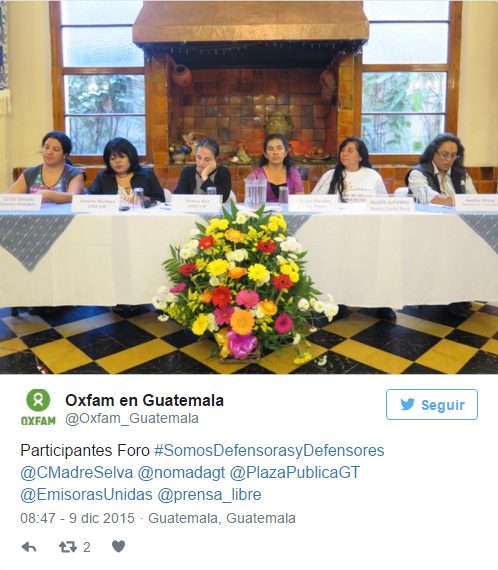
“Participants in the ‘We are Rights Defenders’ Forum.”
Women from various communities struggling against unwanted resource extraction projects throughout the country gathered in the capital Guatemala City to discuss the repression, criminalization, and violence disproportionately faced by women rights defenders, especially indigenous women, Prensa Latina reported.
Among the representatives were women from the community of La Puya, in central Guatemala, where they are key leaders in the blockade against the construction of a gold mine and central to the movement’s strategy of nonviolent resistance.
ANALYSIS: Facing Violence, Resistance Is Survival for Indigenous Women
The women called attention to the links between violence against women and the development model in Guatemala based on privatization, mining extraction, and exploitation of natural resources.
“When repression is committed by mining company security guards, soldiers, and police, rape and sexualized violence have also been used against women and girls,” said Russell. “When communities suffer health harm due to mining contaminated water sources, women and children suffer the consequences most.”
Forced displacement can also disproportionately impact women, Russell explained, as men sometimes accept low-paying mining jobs in exchange for their land behind the backs of women.
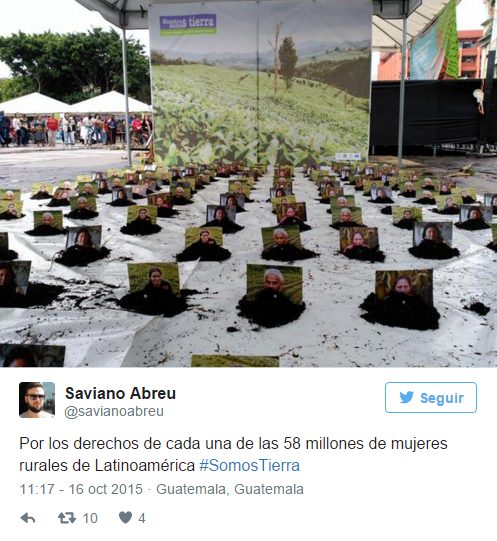
“For the rights of each one of the 58 million rural women in Latin America.”
According to women’s organizations present at the event, a femicide is committed in Guatemala every 10 hours, and one in every 10 women experience some form of gender violence. Guatemala, along with neighboring Central American countries El Salvador and Honduras, are among the worst countries in the world for gender violence and femicide.
Guatemalan activist, feminist artist, and politician Sandra Moran explained that women rights defenders regard women’s bodies, land, nature, history, and memory as all “territories in dispute,” Prensa Latina reported.
ANALYSIS: Femicide in Mesoamerica Persists as Systemic Gender Violence
According to Moran, violence against women “is a mechanism and effect of structural, patriarchal, capitalist system,” and this violence is used by the state to “control resistance, alternative proposals, and to maintain control over the bodies, sexualities, and lives of women,” she told teleSUR English earlier this year.
The activists’ message echoed the findings of a recent report by the Mesoamerican Initiative of Women Humans Rights Defenders, which found that women defending land and territory in the face of mining operations and other projects between 2012 and 2014 were the most vulnerable among all women rights defenders in Central America and Mexico to gender violence, including harassment, abuse, assassination attempts, and other attacks.
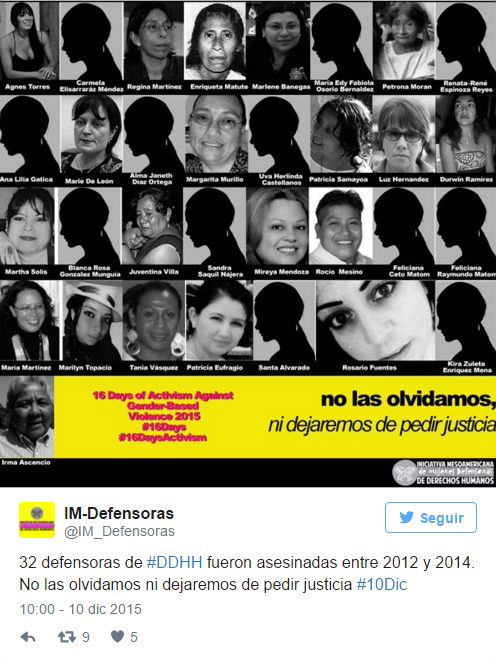
“Thirty-two women human rights defenders were murdered between 2012 and 2014. We do not forget them nor will we stop asking for justice.”
“It is extremely difficult to hold mining companies or government authorities, including police and soldiers, accountable — both in Guatemala and in Canada and the U.S. where most companies are based — when they carry out mining-related repression in general, let alone when it has doubly negative impacts on women and girls. Mining companies operating in Guatemala benefit from and contribute directly to the reigning impunity and corruption,” said Russell, referencing the precedent-setting case attempting to hold Canada’s Hudbay Minerals accountable in Canadian court for the rape of 11 indigenous women.
IN DEPTH: Women Resist
The call for more attention to be paid to the plight of women rights defenders comes ahead of the conclusion of the COP21 climate summit in Paris, where organizations and activists have slammed the draft deal for being weak on human rights protection and the recognition of indigenous communities in the context of climate change.
According to Global Witness, Guatemala is one of the 10 most dangerous countries in world for land and environmental defenders.







 Keeping the spirit
Keeping the spirit Start with a small circle: each one invite one.
Start with a small circle: each one invite one.